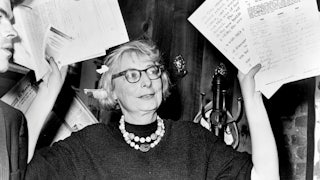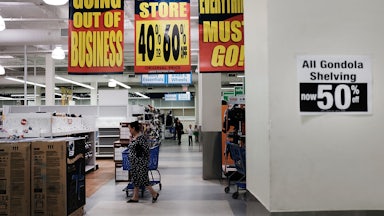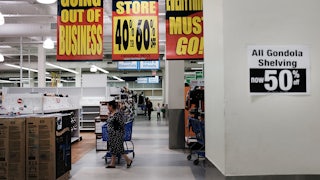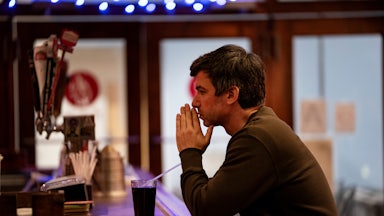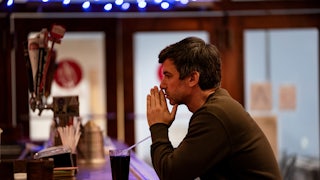Spring of 2020 was not a good time for most people in New York City: The streets were deserted, sirens dominated the soundscape, and refrigerated trailer trucks could be seen parked outside of hospitals to store the casualties of the coronavirus. In some ways, Manhattan resembled its past self before the mass gentrification of the 1990s: with fewer people, more haunted and decrepit. Those who were on the street were predominantly less well off: nurses, food deliverers, sanitation workers, and others who could not flee to their family home in Connecticut or cabin upstate. In short, the virus scared away the college students, the hedge fund managers, and the bankrolled hipsters who had come to dominate neighborhoods like the Lower East Side, East Village, and Williamsburg.
If we are to believe the new book from Jeremiah Moss, Feral City: On Finding Liberation in Lockdown New York, those who remained were made of stronger stuff. They stayed because they needed to work in essential services, because they lived in housing projects, because they were queer people who had cut family ties, or simply because they were enamored with the idea of being the most Nu Yawk New Yorkers and their love meant not abandoning the metropolis. Moss, a psychoanalyst and author of the Vanishing New York blog and book, was what he calls a “Leftover,” biking around the depopulated streets and taking in every minute, particularly the absence of the “New People,” his despised moniker for selfie-taking, brunching, monied schmucks who had slowly been ruining New York since he moved there in 1990.
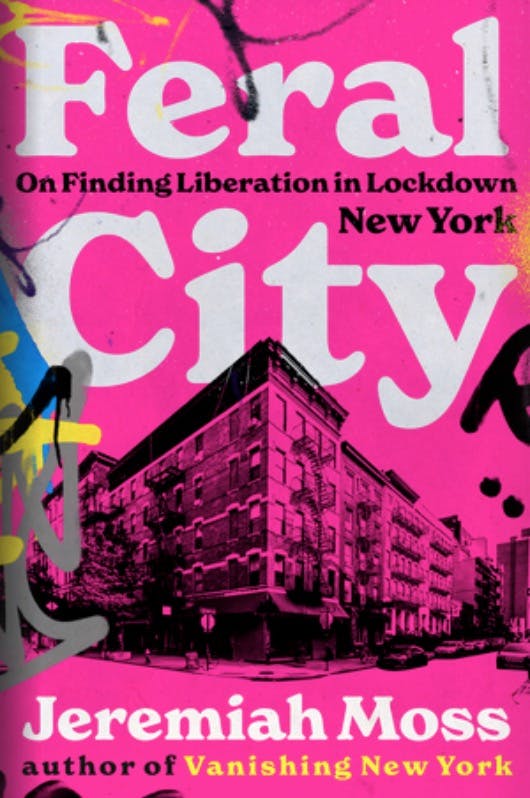
Moss’s plague-years diary is one of elation: The once again spooky city was a liberating space that reminded him, as a progressive trans man, what brought him there in the first place. For most of the world, the pandemic was an unremediated crisis. For Moss, it was exactly what New York needed. His account is raw, angry, filled with self-righteous invective against hypernormals (grossly characterized conformists who do not fit into Moss’s tribe), and blasé about the health crisis of Covid-19. It is also perhaps the best book on gentrification written in a decade.
Moss has lived in a rent-controlled apartment in the East Village for 25 years. He is the beneficiary of a program that hardly exists now but also the victim of the market-rate renters who filled his building and neighborhood. Moss passionately hates them for their ordinariness, apathy, and blind consumerism. Sometimes he kicks their delivery boxes, chanting: “Amazon, Amazon, Amazon. Sephora, Vineyard Vines with smiling, pink, preppie whale. Kick, Kick, Kick.” He dubs his neighbors The Influencer and Alpha Boy and notes that they order all-white interiors from IKEA while his furnishings were found on the street. Moss is a grouch from central casting; he hates the “young and funded” because “they didn’t use to come here. They were intimidated by the city’s boisterous diversity.… [It was] long discredited by the Heartland—for being too Jewish, Black, queer, too dirty, sexual, and untamed.” After giving his neighbors’ packages a good jostling, he reads the names and googles the recipients, hate-browsing their Instagram accounts. The newbies lack the messiness he loved about the city: “pasteurized and homogenized, the New People look like a J. Crew catalog.” Drawing on his own career as a therapist, he recognizes his loathing as something more than resentment; it is a kind of childhood trauma of growing up in the wrong body and unpopular. Now “the popular kids want to push us out, but I’m not leaving,” Moss tells us, with more than a hint of middle-aged animus toward the young.
His account of the new East Village, devoid of greasy spoon Ukrainian restaurants, punk dive bars, and first-generation bohemians (who were, cough cough, also gentrifiers in the 1990s) is funny and gorgeously written. Moss is self-aware; he knows that he is a scold and killjoy and gives the reader a crash course in how these traits are part of a long tradition of queer social critique. His own analyst likens him to Bartleby the Scrivener, constantly intoning, “I would prefer not to.”
Less convincing is the cross-class and racial alliance that makes up the Leftovers. The pandemic made visible that “New York belongs to these ‘queers’—the ones outside the center—the Black and trans, punk and poor, the immigrant, dissident, and resistant,” Moss tells us. As in so many accounts of progressive coalitions, the basket of allies is filled to bursting. For those who hold this view, everyone from impoverished Guatemalan migrants to the local leftie outsider who writes a zine from their Park Slope brownstone, to the queer performance artist who pays $50,000 a year to attend Pratt but is on the level is included in this category. According to Moss, who bikes around the abandoned city in his “New York Fuckin City” T-shirt, these people know how to truly appreciate Manhattan. They do not look at their phones, they don’t take selfies, they dance in Washington Square Park, and “no one’s worrying about how they look because everyone looks like themselves.” This is a vision of the “cool people”; it is not a story about the Bronx cab driver, the nurse from Queens, or the shopkeeper from Borough Park. Those people also stayed during the pandemic and potentially suffered quite a bit, but their narrative is hardly mentioned because they do not recognize themselves in the coalition of Moss’s “true” New Yorkers.
The flaneuring around pandemic New York becomes more focused in the second half of the book, which is an ethnography of Black Lives Matter actions in Manhattan. Moss experiences satisfaction when the windows of luxury-brand stores are smashed: The daily visual assault of products most residents cannot afford is finally being challenged. Likewise, the absence of hypernormals reopens urban space to working-class people and people of color who have been pushed out of the city’s center during endless waves of gentrification. He giddily joins Bike Life riders: young Black men popping wheelies on the empty streets. Like many white participants in BLM, Moss questions his role there and also marvels at how a nearly 50-year-old trans man can cruise the streets with African American teenagers. At times the analysis is spot on, but it also sometimes devolves to a regrettable form of oppression cataloging, drawing not just on Moss’s working-class background but on his assertion that he belongs as an outsider because he is an “ethnic white” of Irish and Italian origin, as if these categories carried intense stigma when he was born in the 1970s. Indeed, the constant bohemian credentialing is tiresome and sometimes cringe-inducing.
What gets lost in this overly broad portrait of outsiderness is not only pertinent economic differences but also a larger sense of solidarity that makes room for “normies” who may study at NYU but want to be a public hospital pediatrician, “bros” from Nebraska who live in Murray Hill but are teaching math at a public high school, and anyone else who fails to meet bohemian aesthetic categories. The problem is not unique to Moss but a central issue in American politics: stretching the identity categories of marginalization does little to build a broader sense of solidarity or a common mission. In New York during the pandemic, solidarity was exhibited by the doctors who kept intubating patients, the teachers who slogged through Zoom classes, and the clerks working at supermarkets; but many of these people, including those of color, work to build better communities without seeing themselves as outsiders.
All of us want to have the city to ourselves, and Moss is no exception. It was built for nine million people, but we all would like to cruise down the Brooklyn Bridge alone or be the only person looking at Impressionist paintings at the Met. Wanting everyone else to take a hike is a very New York sentiment, and Moss yearns for a time in the city’s history (the 1980s and 1990s) when places like the East Village were underpopulated thanks to divestment, redlining, and even landlord arson for insurance money. After New York’s bankruptcy in 1975 (when the “drop dead” federal policy toward the city was coined), downtown Manhattan became an example of white flight and the hollowing out of the urban core. Gorgeous neoclassical buildings were mere shells, and wrought iron facades in SoHo served as dirt-cheap artists’ lofts. This situation could not last, and by the time Moss got to the East Village, 30 years ago, it was swiftly changing.
As in most writing on gentrification, Moss dislikes the people who came after him. He accuses them of purposefully bumping him on the street and tormenting him with their loudness. There’s a bit of paranoia and caricature in this account of the bros with their golf clubs. It is easier, and perhaps more plausible, to imagine not the frat boy and Lululemon-clad Instagrammer but the monied newcomer who tries too hard to be chic and bohemian with tousled hair, sloppy tattoos, and a Strand bookstore tote bag. Nonetheless there is something gratifying about Moss’s hatred. It is so pure and bellicose. It is not a dirge for the lost city but a bloodcurdling scream.
In a chapter titled “You wanted the 1970s, You got the 1970s,” we learn that disorder from protests or small acts of anarchy is slightly frightening but a lot of fun. Those who lived through NYC in the 1970s might not be so sure about that. Even Moss, who provides a lot of righteous protest-porn accounts of breaking things and shouting at complacent outdoor diners, is taken aback when the vintage store across the street from his place is burglarized. He relishes the naked, psychologically disturbed Jesus look-alike lying in the Washington Square fountain. The performance of Crackhead Barney sitting next to people on benches exposing her underwear, then slowly grinding her pelvis, and finally smashing her rubber baby doll against the pavement is “a glorious and vulgar disruption” that Moss “can’t get enough of.”
At points we are left to wonder if this is the same person who hates his neighbors’ music and the people who drink too many mimosas at brunch. “Impulses, constrained by the order of civilization, are pushing upward … unchecked by the pressure to perform and produce, the id’s libidinal energy—the force of life—thrusts against imposed limitations until it breaks through.” The East Village becomes a paradise for old-timers again, who have street parties that are far more democratic than the new neighborhood where newcomers might blow a grand in a weekend out on the town. But the bourgeois newcomers are not having it. Their loss of control of public space for their own expensive consumption habits pisses them off. They are used to a kind of quiet authority that their presence alone guarantees. As Moss puts it: They “exert the Law of the Father over the liberated, feminine-chaotic city.” They don’t need to call in the riot cops in most cases, they can just quietly sip a chardonnay on the terrace of a fancy restaurant and claim ownership of a neighborhood that was once poor, grungy, and mostly Latino.
The embrace of exuberantly out of control New York is often qualified and contradictory: Moss is, at times, realistic about the pleasure and fear that the new/old ethos of the city evokes. But he also is full of double standards. Moss is enraptured when a Puerto Rican neighbor yells at a hypernormal neighbor, “I’m gonna keep yelling until you come down here and tell me to my face to be quiet. Fuck you!” Yet he is apoplectic when people yell at him for “salmoning”—going the wrong way down a bike lane on a one-way street, a maneuver that forces two cyclists to compete for space and potentially cross into the path of traffic. Like Moss’s limited vision of whom the city belongs to, his ideas about street decorum are subjective. People taking selfies of the Washington Square Arch are trash, but the “Rev” who pokes cops in the chest with a rapier sword before being peacefully and quietly sent off for evaluation at a mental hospital is an indispensable piece of classic New York.
For all the limits of Moss’s political vision, the book provides a vivid narrative of hypergentrification at a time when urban rents have produced cities where poor people have nowhere left to go but out. Those who can remain must do so under conditions of extreme discomfort: “We the Leftovers, the non-normatives, the queer in every sense of the word are tired of being squeezed and controlled and told to like it,” Moss says of those who exist in this new gilded city. The plague years are for him a moment of reprieve, a Proustian bite of madeleine that gives a taste of the past for only a brief moment.
The book ends with yet another renovation in Moss’s building. Not a renovation aimed at pricing out rent-controlled tenants with fees but at converting apartments to short-term leases by the room: “essentially SROs for kids with money.” The new East Village still has St. Mark’s Street selling countercultural tchotchkes, but even the wealthy are exploited: paying to live the 1970s nightmare of a claustrophobic bedsit. Thankfully for Moss, they will probably only last a couple years before they move on to New Canaan.


